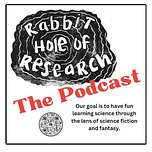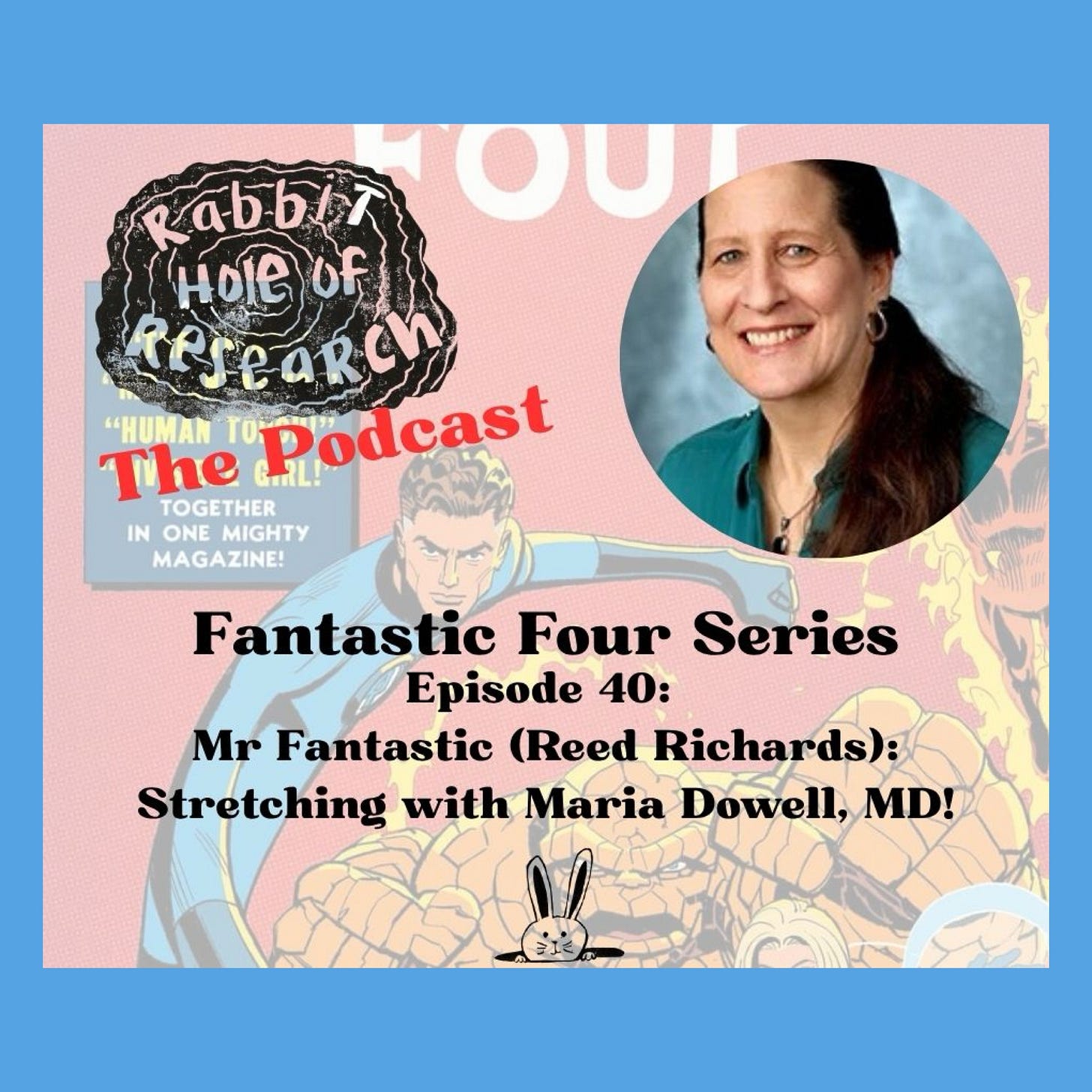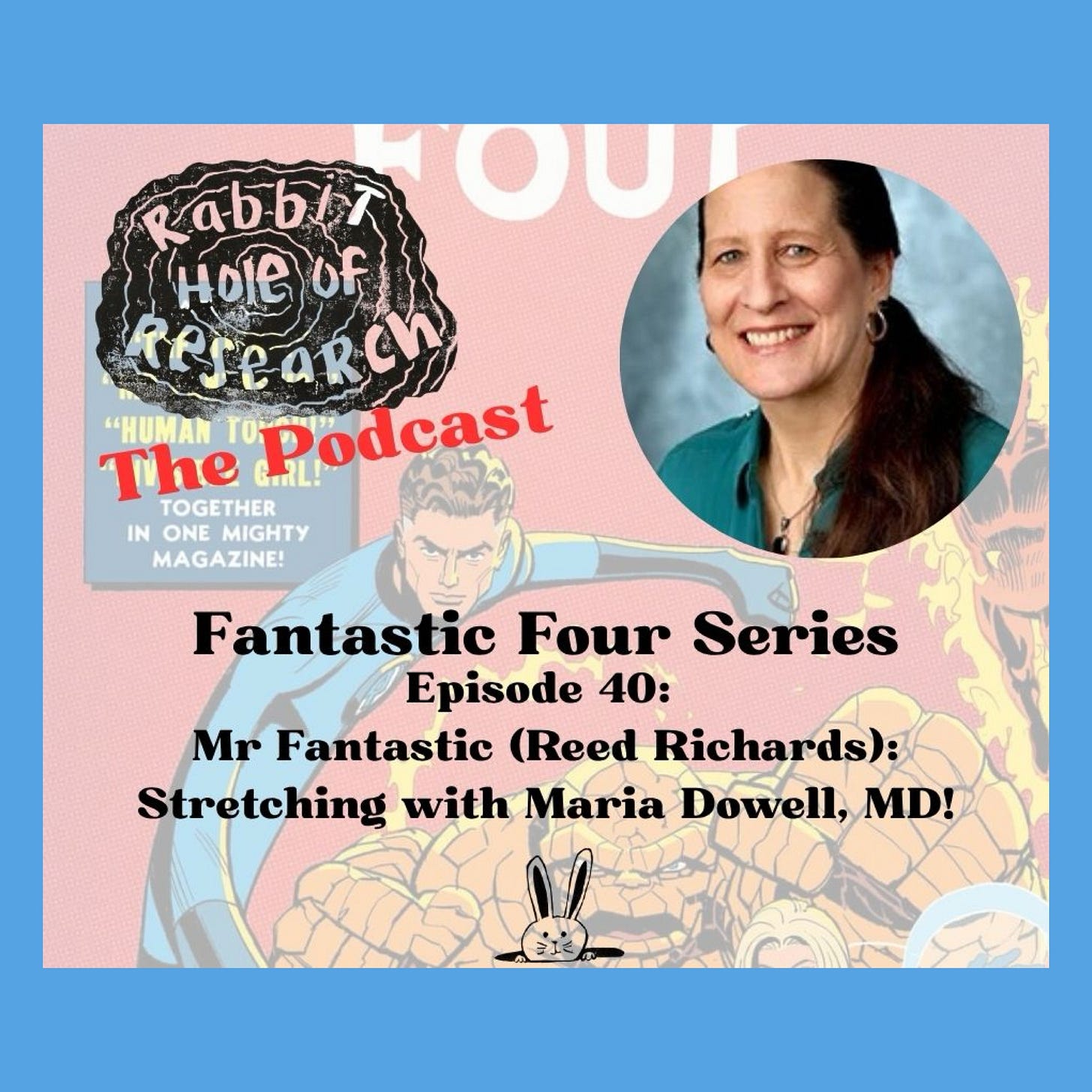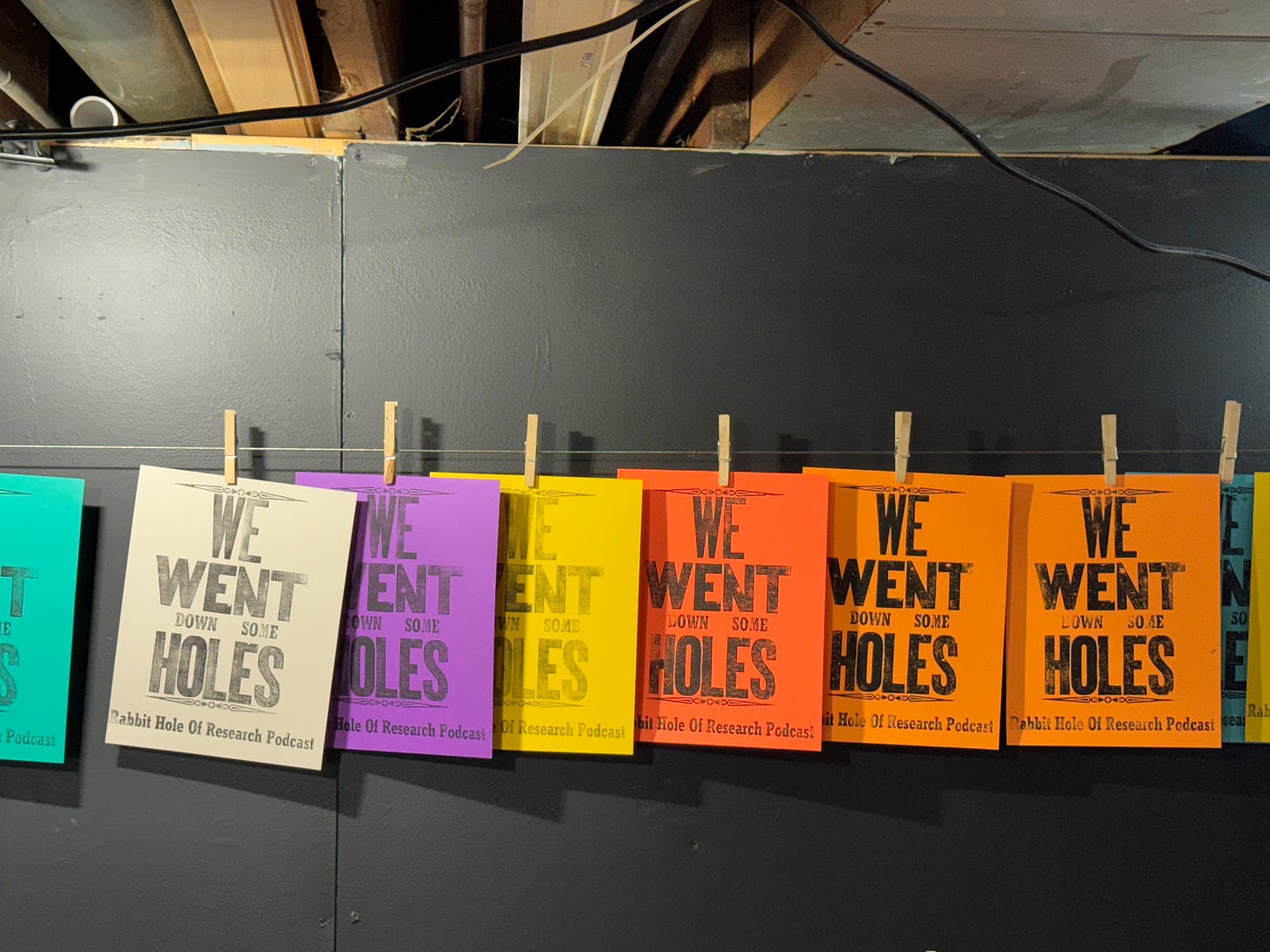In Episode 40 of Rabbit Hole of Research, we conclude our Fantastic Four series by stretching the limits of biology—literally. With special guest Maria Dowell, MD, pediatrician at Laurie Children’s Hospital and faculty at Northwestern, we explore the anatomy, biomechanics, and energy demands behind Reed Richards, aka Mr. Fantastic. From the physics of skin elasticity to the implausibility of flexible bones, we unravel what it would take for a human body to elongate, reshape, and rebound like a superhero. We also examine insect proteins like resilin, speculate on non-Newtonian extracellular matrices, and calculate how many Big Macs it would take to fuel a full-body stretch. It’s elasticity, evolution, and extreme biology—taken to comic book extremes.
Catch up on the rest of the Fantastic Four series before you go see the movie (July 25th):
EP37: Sue Storm and Invisibility
What does it take—biologically—for a human to vanish? Guest: Writer and cultural critic Nick Ulanowski.
EP38: Ben Grimm and The Thing About Skin
NYT bestselling author Jonathan Maberry joins us to explore the handwavium, biology, and symbolism behind strong skin—from the Thing’s rocky dermis to memory tattoos and the scars that shape identity.
EP39: Johnny Storm and Spontaneous Combustion
We torch the handwavium behind Marvel’s hottest character—Johnny Storm, the Human Torch. Dr. David Pincus of the University of Chicago explores how biology might survive a “Flame On!”
And don’t forget to Pre-order: Red Line: Chicago Horror Stories Anthology featuring a new story by Joe!
The Scientist Article Featuring Joe: How Speculative Fiction Expands Scientific Horizons
It’s Science for Weirdos
Want to support the show? Tell your friends. Follow us on social media, Discord, share the podcast, and let us know what topics you are excited about. Leave a Comment. And for email alerts sign-up for the Substack newsletter and never miss an episode, exciting updates or the bonus images we talk about on the episodes.
We want to Hear From You (leave a comment):
If you could have one superpower from the Fantastic Four, which would you choose—and why?
What’s your theory for how Reed Richards avoids ripping his skin or dislocating joints?
Should comics even bother with scientific explanations for superpowers—or just embrace the weird?
Future Episodes & Events
EP41: Crimes Through Time
Releases August 6
Author Lee Matthew Goldberg joins us for a time-twisting dive into memory, criminal psychology, and what crime even means when time is nonlinear.
EP42: Broken Futures: Trauma and the Human Condition
Releases August 20
Author Ben Tanzer joins us to examine how trauma reshapes the mind, the body, and our imagined futures.
EP43: Animal Swarms
Releases September 3
Swarm behavior, emergent intelligence, and the biology of the collective—science communicator Josh Fisher joins us to explore the strange genius of animals that move as one.
EP44: H20MG: Lake Michigan, Life, and Everything in Between
Releases September 17
Cultural critic and writer Maud Lavin joins us to explore Lake Michigan as biome, metaphor, and muse. We dive into the intersections of ecology, identity, politics, memory, and myth.
Events:
Live Q&A Event: Joe will be doing a book club Q&A at Reed’s Local on July 29 for Will You Still Love Me If I Become Someone Else by Jotham Austin II. Event details here
Dragon Con: Joe will appear as an Attending Professional at Dragon Con in Atlanta from August 28 – September 1. Join him for panels, shop talk, and rabbit holes galore.
For more stuff (Images, Episode Highlights, events, etc), subscribe to our Substack newsletter!
Stay curious, stay speculative, stay safe, and we’ll catch you in the next rabbit hole. Love Y'all!
Show Notes & Fun facts
Resilin is an insect protein that can stretch 300-600% and return to shape with >90% efficiency—far better than human elastin.
Stretching your arm 10x its normal length while conserving mass would reduce your strength by ~90%.
Octopuses have no bones and distribute control through their limbs—like Reed might need to.
A functional human parachute made of your own skin would require ~40 m² of surface area and reduce thickness to ~0.25 mm.
Mr. Fantastic’s powers imply an entirely fictional extracellular matrix, possibly shear-thickening or dynamically cross-linking.
Episode Highlights:
00:00 – Welcome to the Rabbit Hole of Research
Joe opens the episode with a nod to the biological and metaphorical meanings of “stretching.”
00:08 – Introduction to Mr. Fantastic
Reed Richards enters the chat as we set up the biology and handwavium behind Marvel’s stretchiest mind.
00:23 – Meet the Crew and Special Guest
Dr. Maria Dowell, MD from Laurie Children’s Hospital, joins the conversation to lend her medical expertise.
01:03 – Background on the Fantastic Four
A quick history of the team’s comic book origins and their place in superhero science fiction.
02:40 – Defining Stretching in Science and Fiction
From biomechanics to metaphor, what does it mean to stretch—materially, biologically, and narratively?
03:50 – Debating the Science of Stretching
We dive into how stretching works at the tissue level and where reality begins to break down.
05:01 – Exploring the Biology of Mr. Fantastic
Could a real human ever expand and retract like Reed? We break down the structural limits of the human body.
06:32 – Comparing Stretching to Other Superpowers
Is stretching more “realistic” than flight or fire control—or does it break biology in different ways?
09:18 – The Role of Intelligence in Superpowers
Is Reed’s brain as flexible as his limbs? We examine the cognitive load of controlling a fluid body.
10:03 – Speculating on Mr. Fantastic’s Abilities
Muscles, joints, and mass distribution—how would a hyper-elastic body function moment to moment?
14:43 – Theories on Mr. Fantastic’s Physiology
We propose speculative models: distributed nervous systems, hydrostatic skeletons, and shape memory proteins.
15:14 – Stretching Limits and Regeneration
How much damage would real stretching cause—and how fast would Reed have to heal?
20:05 – The Impact of Space on Stretching
Would zero gravity make stretching easier? And how does Reed hold shape in extreme environments?
26:25 – Nutritional Needs of Superheroes
Fueling elasticity: How many Big Macs does it take to stretch an arm across the street?
28:13 – The Role of Resilin in Stretching
We spotlight this insect protein that stretches 300-600% and rebounds with almost no energy loss.
31:23 – The Ethics of Stretching Powers
What are the psychological, social, and medical implications of having a body that doesn’t break?
31:42 – Mr. Fantastic vs. Dr. Doom: A Complex Relationship
How does Reed’s power intersect with his morality—and what makes him Doom’s greatest rival?
33:17 – Interdimensional Mass and Stretching Theories
Is Reed pulling mass from other dimensions? A speculative look at space-folding elasticity.
35:01 – Stretching Limits: Comparing Superheroes
From Elastigirl to Luffy, how do other stretchy characters stack up biologically and narratively?
36:25 – The Science Behind Superpowers
Why audiences crave realism even in the most implausible settings—and how science helps ground the story.
40:05 – Non-Consensual Superpower Gaining
A discussion of body horror, mutation, and the trauma baked into origin stories like Reed’s.
42:10 – Genetics and Superhero Offspring
What would Reed and Sue’s kids inherit—and how do fictional genes even work?
46:03 – Theories and Speculations on Superpowers
A rapid-fire round of speculative biology—from ECMs to neural remapping to cellular architecture.
49:04 – Pop Culture References and Stretchy Characters
We unpack media representations from Plastic Man to Stretch Armstrong.
57:42 – Concluding Thoughts and Movie Excitement
Final reflections, The RHR crew making plans to see the Fantastic 4 movie (July 25th release), and a thank-you to Dr. Dowell.
Join Rabbit Hole of Research on Discord: https://discord.gg/2nnmKgguFV



















Share this post